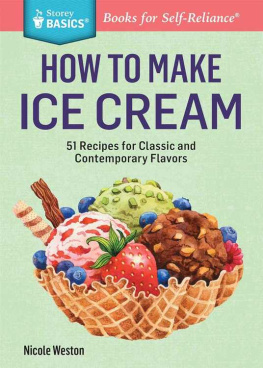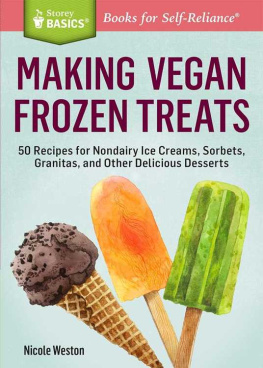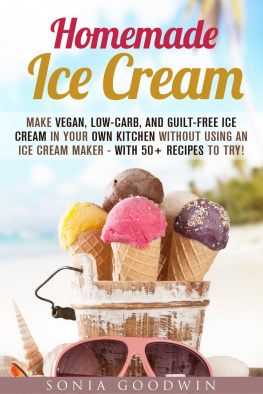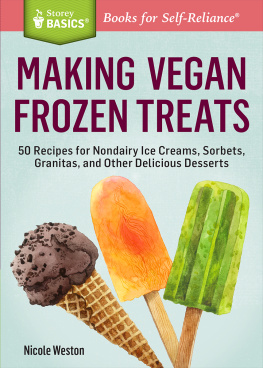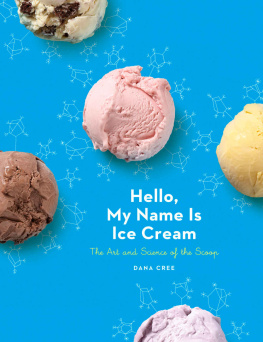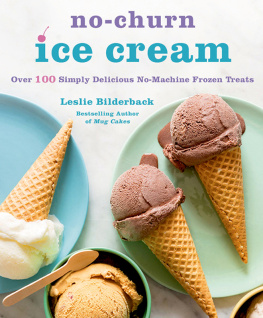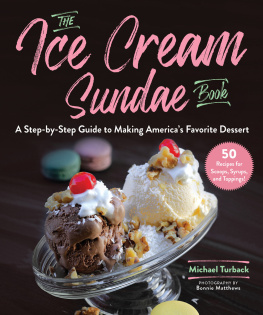Contents
Part One
Introduction to Ice Cream
On a hot summer day, very few things taste as good as a bowl full of ice cream. Ice cream is a treat that appeals to people of all ages, from kids waiting in line for a cone at an ice cream truck after school to adults indulging in a scoop of some specialty flavor as a component of a plated dessert at a fine dining restaurant. It is unique because it is rich and indulgent, yet it often reminds us of our childhoods. It can serve as dessert in its own right, and it can accompany other desserts as a side. And because of its ubiquitousness in grocery store freezer cases, we sometimes forget just how special ice cream really is.

Homemade ice cream is even more special than anything that an ice cream truck, a restaurant, or a grocery store can deliver. You can not only customize the flavors and ingredients to create your favorite flavors, but youll probably also be surprised by just how easy it is to make it yourself. Homemade ice cream can rival premium store-bought ice creams and can easily eclipse the less expensive brands with superior flavors and a richer texture. The only downside to starting to make your own ice creams at home is that you may find it difficult to go back to store-bought unless youre simply searching the grocery store aisle for inspiration for your own flavor creations.
What Is Ice Cream?
At its most basic, ice cream is a mixture of frozen cream and a sweetener, paired with a flavoring agent of some kind, such as vanilla, fruit, or chocolate. There are two main styles of ice cream. French-style ice cream starts with a cooked custard base made with milk, cream, sugar, and either eggs or egg yolks. This ice cream base is very thick, with an almost puddinglike consistency before it is churned. It produces a very rich ice cream with a velvety smooth texture and a slightly eggy flavor. American-style ice cream, also known as Philadelphia-style ice cream, typically has a lighter and more fluid consistency than that of French-style ice creams. It is made with milk, cream, sugar, and flavorings, but it does not contain eggs. It has a more pronounced dairy taste that is a good base for other flavors to be added.
Neither of these two styles of ice cream is better than the other. It all comes down to personal preference when you are making your recipes. Some people prefer the richer, eggier French-style ice cream, and others prefer the lighter and simpler taste of the American-style ice cream. And plenty of ice cream fans like both styles equally well. I like the consistency of both types of ice cream and find that some flavors work better with one base than the other. Fruit ice creams, for instance, have a brighter flavor when they are made with an American-style base because the added richness of the eggs in the French-style ice cream can mute the flavor of the fruit. Chocolate ice creams, however, can feel even more decadent and mousse-like on the tongue when made with a French-style base.
How Ice Cream Is Made
Ice cream is not made by simply pouring cream into a freezer. Ice cream is made by quickly freezing a flavored base mixture while agitating it, whether you are vigorously shaking it or slowly stirring it. Fast freezing allows the mixture to set up without forming large ice crystals that would result in a finished product that was more like a chunky snow cone than a silky smooth cream.
Agitating the ice cream base has two functions. First, the motion helps the base cool down very quickly and prevents large ice crystals from developing as it chills. Second, agitation adds air to the mixture as it freezes, which creates an ice cream with a soft texture that will be scoopable when frozen. That added air also makes ice cream taste better, because slight aeration allows the frozen mixture to melt smoothly and evenly on your tongue.
The first real ice cream recipes appeared in the early to mid eighteenth century. These recipes called for a small container of cream to be placed inside a larger container packed with ice and salt. The cream was churned or stirred in this insulated environment until it took on a more solid, scoopable consistency. The salt lowered the freezing temperature of the ice, creating a very cold environment where the cream could freeze quickly and smoothly. This process was generally done by hand and was labor-intensive, especially if the ice cream was going to be served to a large group. But like all great things, ice cream attracted innovation to make it easier to produce and more accessible. A patent for the first hand-cranked, home ice cream maker was issued in 1843 and was a huge step in streamlining the production process. An even bigger step was the propagation of refrigeration, which allowed ice cream to be prepared in bulk, shipped to more people, and stored for long periods of time.
Ingredients
As with most homemade recipes, if you start with the best quality ingredients that you can find, your finished product will have the best possible flavor. High-quality cream and milk will give your ice cream a rich dairy flavor that you will be able to taste in every bite. These recipes typically call for heavy cream or heavy whipping cream, and whole milk. The fat in these products is what makes ice cream both light and rich. There is no substitute for the heavy cream. Whole milk will definitely give you the best results, but you can substitute reduced-fat milk to make the ice cream a little bit lighter without giving up much of the texture of the original recipe.
The sugar in an ice cream base also plays an important role in the finished product. It not only sweetens the ice cream and allows other flavors to stand out, but it also contributes to the creamy, soft texture of ice cream by discouraging the formation of ice crystals in the base as it freezes. You can experiment with reducing the sugar in some recipes to suit your tastes, but keep in mind that the finished ice cream will always taste a little less sweet than the unfrozen ice cream base and that your ice cream may have a slightly icier texture than one made with the full amount of sugar.
Cooking the Ice Cream Base
Some of the ice cream recipes in this book have only a minimally cooked base, where milk is heated just to dissolve sugar, cocoa powder, or other ingredients. This base will have a consistency that is only slightly thickened, and it is always easy to make. Some of these ice creams have a custard base that includes tempered eggs and may take a little extra time to make.
Eggs are tempered when a hot liquid, such as milk, is carefully streamed into them, bringing the eggs up to a very high temperature without cooking them. When properly incorporated, eggs have thickening properties that will help bring a custard to the appropriate consistency. Eggs need to be tempered because they cook very quickly and can easily turn to scrambled eggs instead of custard if not treated gently.

